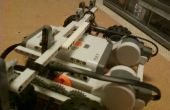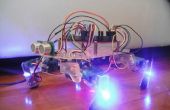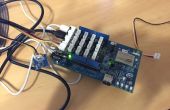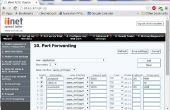Paso 6: Aplicación de los comandos de API PyMata y métodos de informe

MENSAJES de comandos - pymata.py
Luego codificamos los métodos de PyMata API para los tres sub-comandos de motor paso a paso y un método de API para recuperar el número de versión divulgada. Todos los cambios de código para la API se hacen al pymata.py. La primera de tres métodos, stepper_config, stepper_step y stepper_request_library_version traducen el comando en un comando de SysEx con formato correcto que luego es enviado a Arduino. El último método, get_stepper_version, no lleva a ningún mensajes SysEx, pero simplemente devuelve el resultado de una solicitud de versión anterior.
def stepper_config(self, steps_per_revolution, stepper_pins): """ Configure stepper motor prior to operation. steps_per_revolution: number of steps per motor revolution stepper_pins: a list of control pin numbers - either 4 or 2 """ data = [self.STEPPER_CONFIGURE, steps_per_revolution & 0x7f, steps_per_revolution >> 7] for pin in range(len(stepper_pins)): data.append(stepper_pins[pin]) self._command_handler.send_sysex(self._command_handler.STEPPER_DATA, data)
def stepper_step(self, motor_speed, number_of_steps): """ Move a stepper motor for the number of steps at the specified speed motor_speed: 21 bits of data to set motor speed number_of_steps: 14 bits for number of steps & direction positive is forward, negative is reverse """ if number_of_steps > 0: direction = 1 else: direction = 0 abs_number_of_steps = abs(number_of_steps) data = [self.STEPPER_STEP, motor_speed & 0x7f, (motor_speed >> 7) & 0x7f, motor_speed >> 14, abs_number_of_steps & 0x7f, abs_number_of_steps >> 7, direction] self._command_handler.send_sysex(self._command_handler.STEPPER_DATA, data)
def stepper_request_library_version(self): """ Request the stepper library version from the Arduino. To retrieve the version after this command is called, call get_stepper_version """ data = [self.STEPPER_LIBRARY_VERSION] self._command_handler.send_sysex(self._command_handler.STEPPER_DATA, data)
Finalmente implementamos get_stepper_library_version:
def get_stepper_version(self, timeout=20): """ timeout: specify a time to allow arduino to process and return a version the stepper version number if it was set. """ # get current time start_time = time.time()
# wait for version to come from the Arduino
while self._command_handler.stepper_library_version <= 0: if time.time() - start_time > timeout: print "Stepper Library Version Request timed-out. Did you send a stepper_request_library_version command?" return else: pass return self._command_handler.stepper_library_version
Esto completa los cambios a pymata.py. Cierre y guarde pymata.py.
MENSAJES de informe - pymata_command_handler.py
Ahora añadimos el método del controlador informe a pymata_command_handler.py, para que puedan recibir y procesar informes de versión de biblioteca paso a paso. Observe que este método permite volver a montar los datos de la el mensaje SysEx y tiendas en una variable interna llamada stepper_library_version.
def stepper_version_response(self, data): """ This method handles a stepper library version message sent from the Arduino data - two 7 bit bytes that contain the library version number """ self.stepper_library_version = (data[0] & 0x7f) + (data[1] << 7)
Por último, tenemos que actualizar la tabla de command_dispatch para procesar el recibo de la respuesta de versión paso a paso. Añadir una nueva entrada a la parte inferior de la tabla existente para STEPPER_DATA como se muestra a continuación. Cada entrada en la tabla de command_dispatch consiste en el comando de SysEx, el nombre del método de manejo, y el número de valores de bit 7. Los valores de 7 bits se vuelve a montar e interpretados según las especificaciones de los formatos de mensaje SysEx que definimos anteriormente.
def run(self): """ This method starts the thread that continuously runs to receive and interpret messages coming from Firmata. This must be the last method in this file It also checks the deque for messages to be sent to Firmata. """ # To add a command to the command dispatch table, append here. self.command_dispatch.update({self.REPORT_VERSION: [self.report_version, 2]}) self.command_dispatch.update({self.REPORT_FIRMWARE: [self.report_firmware, 1]}) self.command_dispatch.update({self.ANALOG_MESSAGE: [self.analog_message, 2]}) self.command_dispatch.update({self.DIGITAL_MESSAGE: [self.digital_message, 2]}) self.command_dispatch.update({self.ENCODER_DATA: [self.encoder_data, 3]}) self.command_dispatch.update({self.SONAR_DATA: [self.sonar_data, 3]}) self.command_dispatch.update({self.STRING_DATA: [self._string_data, 2]}) self.command_dispatch.update({self.I2C_REPLY: [self.i2c_reply, 2]}) self.command_dispatch.update({self.CAPABILITY_RESPONSE: [self.capability_response, 2]}) self.command_dispatch.update({self.PIN_STATE_RESPONSE: [self.pin_state_response, 2]}) self.command_dispatch.update({self.ANALOG_MAPPING_RESPONSE: [self.analog_mapping_response, 2]}) self.command_dispatch.update({self.STEPPER_DATA: [self.stepper_version_response, 2]}) La mesa de despacho de comando se define como un mapa en pymata_command_handler.py. Estos comentarios del código explican su uso y cómo agregar nuevos comandos a él.
# This is a map that allows the look up of command handler methods using a command as the key. # This is populated in the run method after the python interpreter "sees" all of the command handler method defines (python does not have forward referencing)
# The "key" is the command, and the value contains is a list containing the method name and the number of # parameter bytes that the method will require to process the message (in some cases the value is unused) command_dispatch = {} Guarde y cierre pymata_command_handler.py. Los cambios de cliente ahora están completados.













